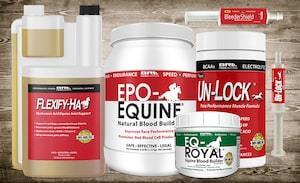
With show season starting up in just a couple of months, soon you’ll find yourself clipping, pulling manes, braiding and banding your horse. Nothing looks more impressive in the show ring than a horse with a long, thick, luxurious tail, but achieving an ideal tail can be a long-term project. Still, there are multiple ways you can care for your horse’s tail this winter to maximize its health so it looks great in the show ring.
Use Mud Knots
Mud and wintry paddock footing can quickly leave your horse’s tail looking tired. If your horse’s paddock is a mess and his tail is long enough to reach the ground, it may be time to tie a mud knot to help keep the tail up off the ground and protected. Tying a mud knot takes a little practice, but it isn’t too difficult. To make the task easier, start with a slightly dirty tail, which helps to keep the knot in place.
Remember that mud knots are only a temporary fix, and you really shouldn’t leave the knot in your horse’s tail for long. Replace the knot daily and use it only as a solution until the footing has improved or you’re able to move your horse to another paddock.
Focus on Nutrition
If you want to truly support a healthy tail, then you need to support your horse’s overall nutrition. A nutritional analysis is a good place to start, especially if you’ve reduced your horse’s grain intake over the winter to compensate for a reduced workload. Examine the feed label of your horse’s grain and see if he’s receiving the recommended minimum amount of feed. If he isn’t, he may not be getting the nutrition that his body needs for overall health, and to support functions like healthy tail growth.
Next, send your hay out for analysis. Hay is a major part of your horse’s diet, and while the hay you’re feeding may look green and tasty, it could be lacking in important nutrients.
Once you have this analysis, you can see potential nutrition shortcomings in your horse’s diet and take steps to fix them, such as by putting your horse on a ration balancer or adding supplements to his diet. Supplements containing biotin may also help support hair growth and quality. If you have questions about how to determine whether your horse’s diet is adequate, contact an equine nutritionist for some help.
Groom to Stimulate Root Growth
Gently grooming the dock of your horse’s tail can help to stimulate root growth for improved tail quality. To start, always work tangles out of the tail by hand, then follow up with a nice massage to your horse’s tailbone and dock with a soft rubber curry or your hands. Do this for a few minutes each time you groom your horse, being careful not to break or pull out any hairs.
Wash Only Occasionally
Try to resist the temptation to wash your horse’s tail often. Frequent washing can dry out the hair and may even leave the skin of your horse’s tailbone dry and itchy, prompting him to scratch. Instead, wash your horse’s tail only on occasion or just before a show, and make sure that you thoroughly remove all shampoo.
Use a Tail Bag
Protecting your horse’s tail with a tail bag through the winter can help support tail growth while protecting the hair from rubbing, irritation and breakage. Remember to unbraid and rebraid your horse’s tail and change the tail braid regularly so that you don’t inadvertently cause more damage than good.
By focusing on your horse’s tail health this winter, you can be well-prepared to head into the show ring this spring.
Top trainers, owners and competitors rely on BRL Equine products to help their horses perform at their very best. You can get the same great results! Our all-natural equine nutritional supplements really work... guaranteed or your money back!





Also in Horse Tips and More
Top 10 Ways to Show Your Horse You’re Thankful For Him
November 01, 2021
View full article →
5 Ways to Prepare Your Barn For Summer
May 03, 2021
View full article →
Your New Spring Horse Health Checklist
March 12, 2021
View full article →